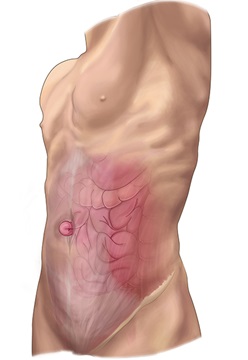Umbilical Hernia

What is an umbilical hernia?
Unlike most hernias, which develop in adolescence or adulthood, 20 percent of babies are born with umbilical hernias. An umbilical hernia occurs at the umbilicus (belly button) when a loop of intestine pushes through the umbilical ring, a small opening in a fetus’ abdominal muscles through which the umbilical cord—which connects a fetus to its mother while in the womb—passes. Umbilical hernias occur most often in newborns, and 90 percent will naturally close by the time the child reaches 5 years of age.
Umbilical Hernia Causes
After birth, the umbilical cord is no longer necessary, and the opening in the abdominal muscles closes as the baby matures. Sometimes, these muscles do not meet completely, leaving a small hole or gap. A loop of intestine can move into and even penetrate the opening between abdominal muscles and cause a hernia.
Umbilical hernias occur most often in infants but can also occur in adults. The most common causes of umbilical hernias in adults are:
-
Chronic health conditions that raise abdominal pressure, including:
-
Carrying excessive belly fluid (ascites)
-
Chronic cough
-
Difficulty urinating due to an enlarged prostate
-
Prolonged constipation
-
Repetitive vomiting
-
-
Obesity
-
Straining such as during child birth or weight lifting
Umbilical Hernia Diagnosis
Hernias are usually diagnosed during a physical examination by a health care provider. The provider will look and feel for a bulge or swelling in the belly button area. The swelling may be more noticeable when a baby cries and may get smaller or go away when a baby relaxes or rests on its back. During the examination, the provider will determine if the hernia is reducible—if it can be pushed back into the abdominal cavity.
The provider will also look for and complete a medical history to determine if the umbilical hernia has become incarcerated (trapped within the abdominal opening), a serious medical condition in which the protruding intestine becomes trapped and deprived of blood supply. The intestine can quickly become necrotic if not repaired, which requires surgical removal of the affected intestine. Symptoms of a strangulated umbilical hernia include:
-
Abdominal pain and tenderness
-
Constipation
-
Fever
-
Full, round abdomen
-
Red, purple, dark or discolored bulge
-
Vomiting
The provider may order blood tests to look for signs of infection resulting from the strangulated intestine. They may also order a barium X-ray, ultrasound, MRI or CT to examine the intestine more closely, especially if the hernia is no longer reducible.
Umbilical Hernia Treatments
Specific umbilical hernia treatment and timing will be determined by the surgeon based on multiple factors such as the child's age, general health, medical history and whether the hernia is reducible or strangulated. By age 1, many umbilical hernias will have closed on their own without surgery. Nearly all umbilical hernias will have closed without surgery by age 5.
In general, if the hernia becomes bigger with age, is not reducible or is still present after age 3, the child's provider may suggest that the hernia be repaired surgically. If the hernia is strangulated and cannot gently be pushed or massaged back into its proper place within the abdomen, the surgeon will generally recommend immediate surgery.
Under general anesthesia, a small incision is made in the umbilicus (belly button). The loop of intestine is placed back into the abdominal cavity, and the incision closed. Sometimes a piece of mesh material is used to help strengthen the area where the muscles are repaired.





